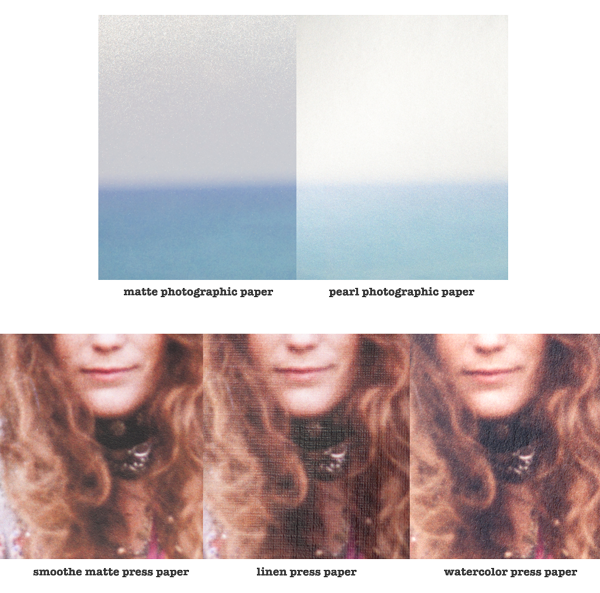Head-to-Head: Photographic Paper Prints vs Press Prints
Any good photog knows the importance of printing their work. With all the fabulous print products available these days, don’t you want to know exactly what you’re getting and why? Join Richard Photo Lab as we take a look at the distinctions between photographic paper prints vs press prints, and why the heck you should care.

Photographic paper prints and press prints are insanely different. Like, 180 degrees, across-the-board different. These differences start in the very foundation of the prints: the methodology by which an image is made. Photographic paper prints, just like film, are light sensitive—exposing the paper to light inside the printer produces the image. Then, just like film, chemicals are used to eliminate the light-sensitivity and set the image, which is now “in” the paper. Press prints, on the other hand, are made by applying ink directly to paper.
Photographic paper prints and press prints use different color spaces to produce an image, which causes minor variances in color. Photographic paper prints exist in the RGB color space because they use light to make the image, while press prints use the CMYK color space, which stands for the four basic colors of ink used in printers (Cyan, Magenta, Yellow, Key—aka black). The RGB color space has a larger color gamut, or range of colors it can produce, than CMYK. Photographic paper prints will always achieve the most precise colors. Press prints may have difficulty reproducing certain colors, though the technology afforded to us today ensures that these prints provide beautiful image reproduction.
Psst, don’t submit your images for press printing through ROES in CMYK; the software is optimized to convert RGB to the best possible translation of CMYK in our press!

These differences in both methodology and color gamut result in a different architecture of the printed image. Because the photographic paper print is made with light and is able to reproduce such a large range of hues, the image is made with completely smooth colors and gradients. Press prints are constructed with tiny ink dots (in cyan, magenta, yellow, and black), and their placement and proximity are what creates the image. Check out our extreme close-ups above to see the difference.
Additionally, there is another type of ink printing that isn’t the press—it’s our Inkjet fine art printing. Inkjet printing doesn’t use dots of ink; the ink is actually sprayed by the machine. Not only that, but there are 10 different inks used for Inkjet printing, as opposed to the four used in the digital press. The comparison can be likened to that of a glass filled with ink: with Inkjet printing, if you fill the glass with more and more ink it gets darker. With digital press printing, the ink in the glass gets darker if it is denser; it is only as “dark” as the dots are close. When printing a pastel color, the dots are further apart, which often results in a more visible/textured pattern. Light skies and skin tones can be rather sensitive.

Photographic paper prints and press prints have very distinctive papers, and not just because one is light-sensitive. As seen on the enlarged images of prints above, the surfaces, weights, and tones differ; photographic paper prints have some crazy different finishes, ranging from smooth, deep matte to the soft shine of pearl to intense pop of glossy and beyond. Press papers tend to provide a very different tactile experience, with a range of weights and textures. Another difference between these prints? Photographic paper prints are single-sided, while press prints are double-sided, creating interesting versatility in how they can be presented.
So, what exactly do these differences mean for your photography business? It’s all about positioning. For instance, press printed products can be marketed as something in a totally different price bracket than photographic paper prints by leveraging the labor-intensive nature and extra customization available for the product (i.e., book layout design, greeting card design, etc).
Richard suggests offering more of both: photographic paper prints in your base package as well as unique press products as an additional add-on. Photographic paper prints and Inkjet prints are currently and consistently offered, sold, shown in galleries, and given as gifts by pro photogs as a part of their business model. Press products are also great for use in your business for everything from business cards to mini previews of your larger fine-art prints, even press books as portfolios, album alternatives, or client gifts.
Want to know which of Richard's products are which? You got it!
PHOTOGRAPHIC:
PRESS:
INKJET:
Download the Print App

